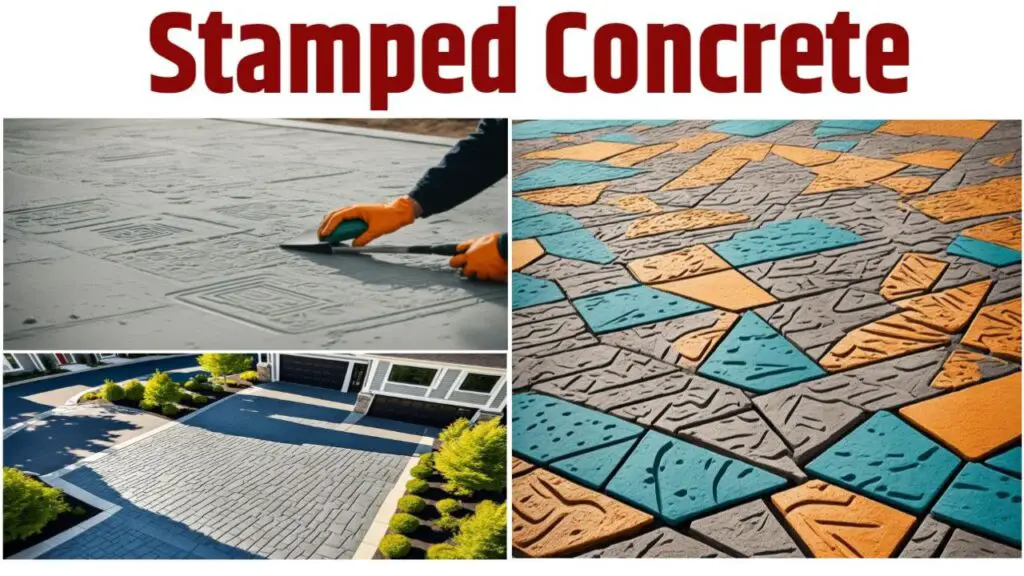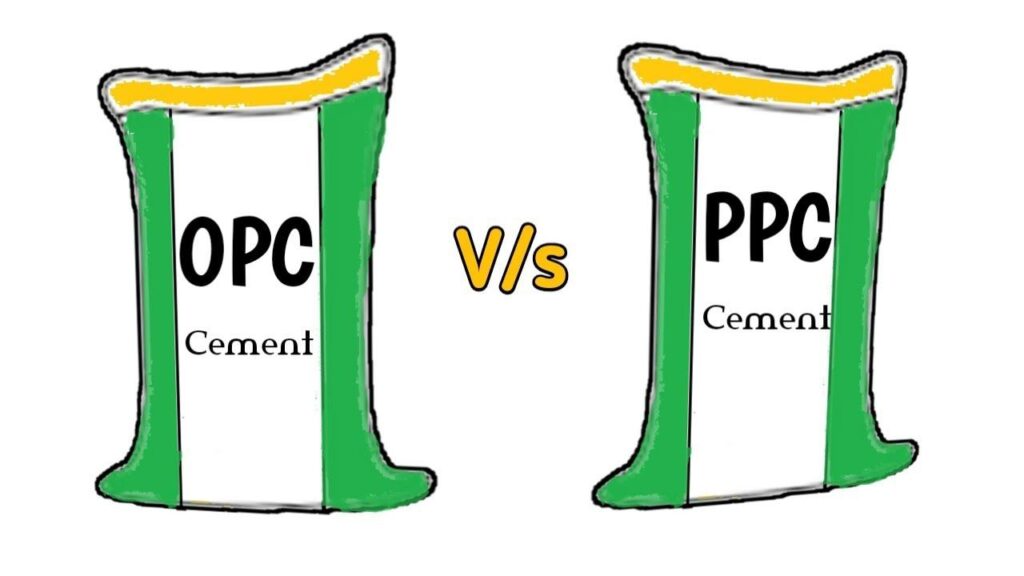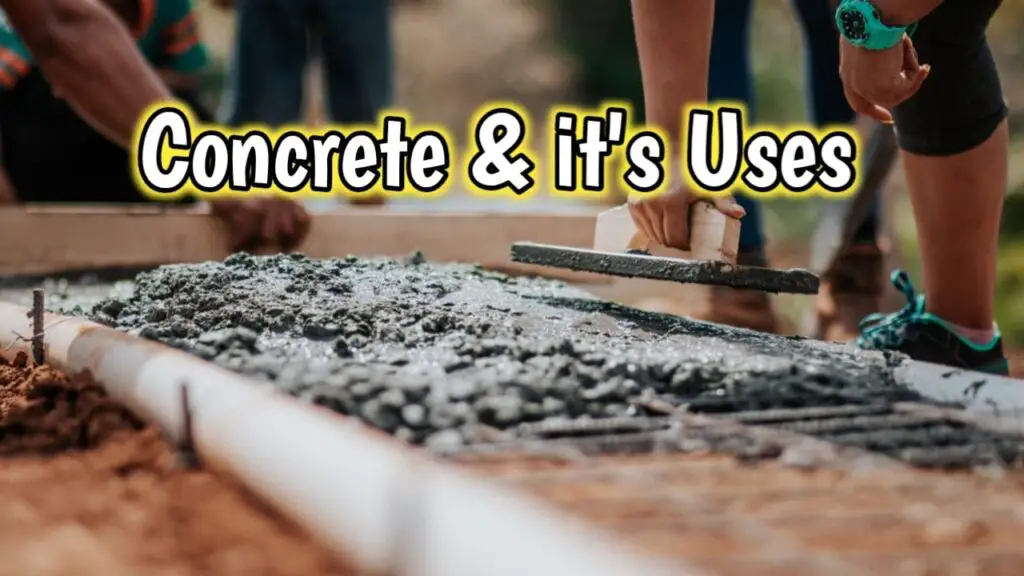Are you considering stamped concrete or imprinted concrete for your next home improvement project? Before you make any decisions, it’s crucial to understand what stamped concrete is and how it can enhance the appearance and functionality of your surfaces.
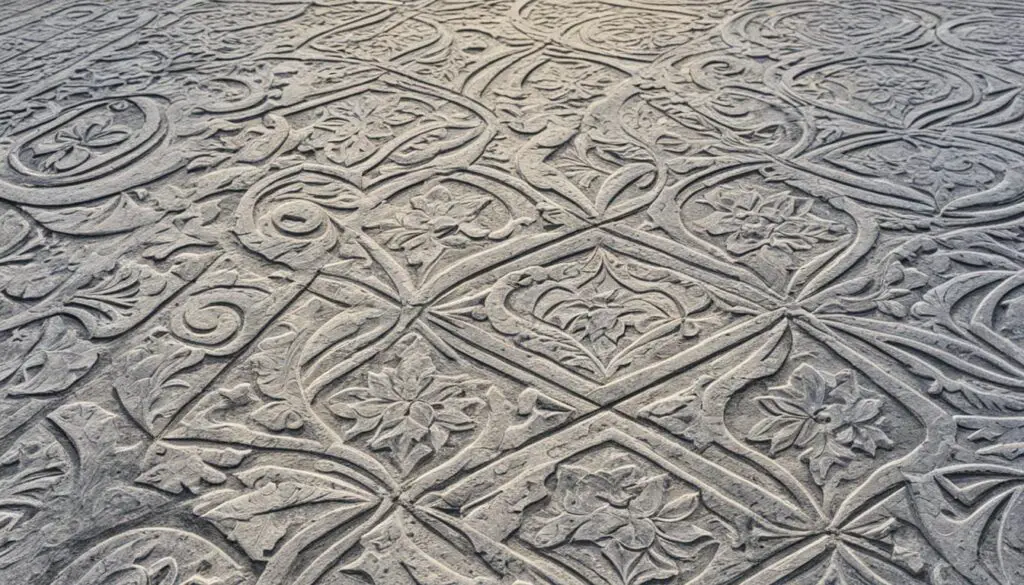
Stamped concrete is a versatile and cost-effective alternative to traditional flooring options. It involves impressing patterns or textures onto freshly poured concrete to mimic the look of materials like brick, stone, or tile. The result is a durable and visually appealing surface that can be customized to match your desired aesthetic.
But what sets imprinted concrete apart from other flooring options? How does it compare in terms of durability, maintenance, and cost? In this article, we will delve into the world of stamped concrete, uncovering its applications, materials needed, process, specifications, and costs. By the end, you’ll have all the information you need to decide if imprinted concrete is the right choice for your project.
Key Takeaways:
- Stamped concrete is a versatile and cost-effective alternative to traditional flooring options.
- It involves impressing patterns or textures onto freshly poured concrete to mimic the look of various materials.
- imprinted concrete offers durability, customization options, and low maintenance requirements.
- Understanding the materials needed, process, specifications, and costs will help you make an informed decision.
- Consider the advantages and disadvantages of stamped concrete to determine if it aligns with your project requirements.
The Versatility of imprinted Concrete
Stamped concrete offers a versatile and aesthetically appealing solution for various applications. Whether you’re looking to enhance the beauty of your pathways, driveways, patios, or pool decks, stamped concrete can transform any surface into a work of art.
One of the key advantages of imprinted concrete is its ability to replicate the look of luxurious materials such as brick, stone, and wood at a fraction of the cost. This makes it a popular choice among homeowners and business owners alike.
Let’s explore some of the common applications of stamped concrete:
- Pathways: imprinted concrete can create stunning walkways through gardens, parks, and residential areas.
- Driveways: Add curb appeal to your property with a stylish and durable stamped concrete driveway.
- Patios: Enhance your outdoor living space with a beautiful imprinted concrete patio that complements your landscaping.
- Pool Decks: Create a slip-resistant and visually striking pool deck using stamped concrete.
But the versatility of imprinted concrete doesn’t stop there. It can also be used for:
- Entrances of hotels
- Car porches
- Entrances of offices
- Entrances of residential buildings
- Common areas of commercial stores
This wide range of applications demonstrates the adaptability of stamped concrete in various settings, be it residential or commercial. With its ability to mimic different textures and patterns, imprinted concrete flooring can enhance the overall aesthetics of any space.
By choosing imprinted concrete, you can enjoy the benefits of a durable, low-maintenance, and visually appealing flooring option that offers endless design possibilities.
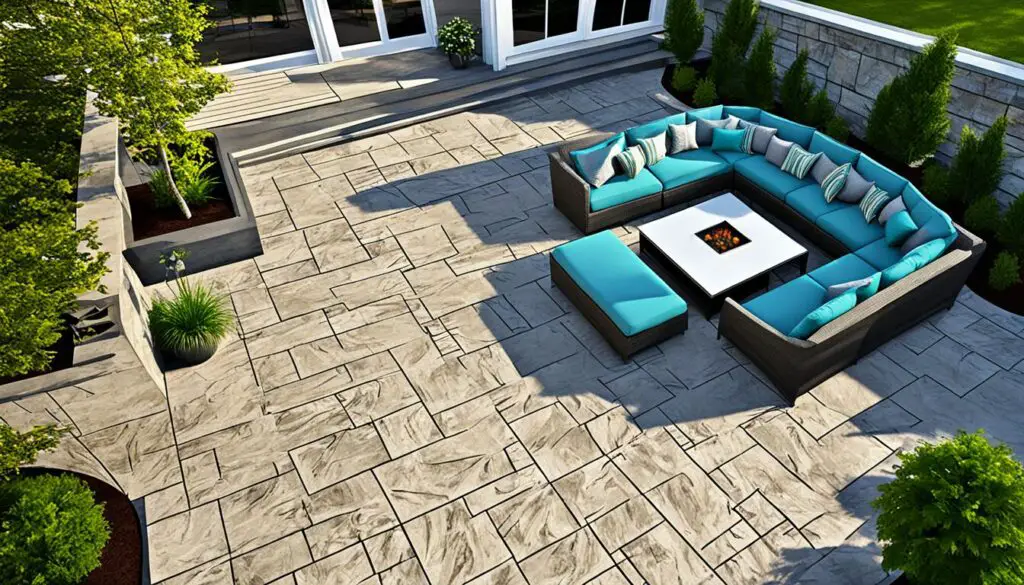
Quote:
“Stamped concrete has revolutionized the way we design and decorate outdoor spaces. Its versatility and durability make it an excellent choice for homeowners and businesses looking to enhance their surroundings.” – Jane Smith, Landscape Designer
Materials Needed for Stamped Concrete Flooring
To achieve a durable and visually appealing finish, certain materials are required for stamped concrete flooring. Here is a comprehensive list of the essential components needed:
- Coarse aggregate
- Fine aggregate
- Water
- Cement
- Roller
- Woods or railing for side boundary
- Concrete mixture machine
- Vibrating machine
- Screeding bar or planner
- Power trowel machine
- Color pigments or color powder
- Rubber pad or rubber molds with imprinted concrete patterns
- Stamping rod
- Wheelbarrow
- Reinforcement or TMT bars of different diameters
These materials play a crucial role in the successful installation and long-lasting performance of imprinted concrete flooring. It’s important to ensure you have all the necessary materials before starting your project.
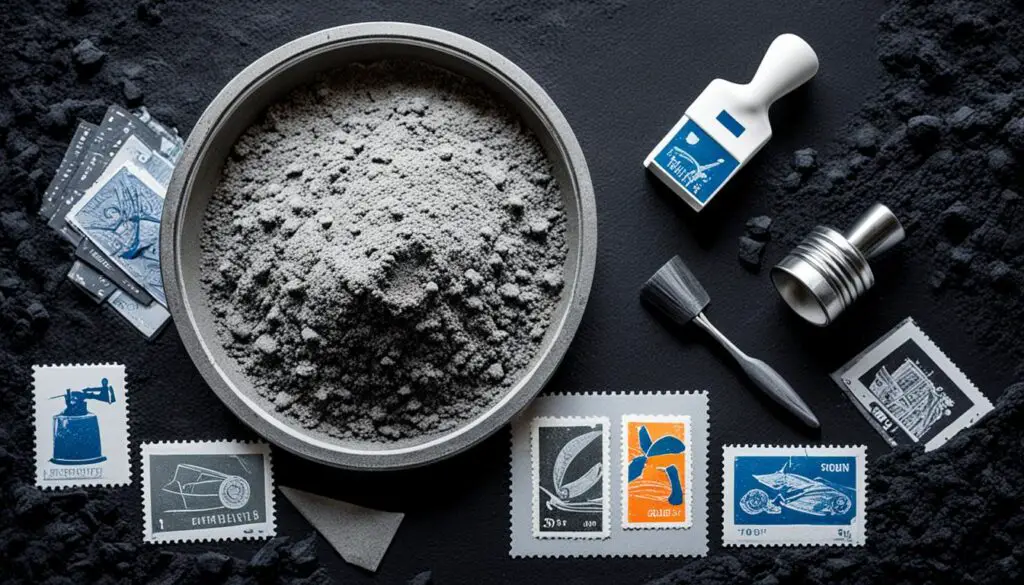
Having the right materials on hand allows you to achieve the desired texture, pattern, and color for your stamped concrete flooring. The use of color pigments or color powder, rubber molds with stamped concrete patterns, and the various equipment and tools listed above will help you create unique and visually appealing designs.
When working with imprinted concrete, it’s crucial to follow the manufacturer’s instructions and guidelines for each specific material to ensure proper mixing and application. Additionally, consider consulting with a professional contractor who specializes in stamped concrete installations for expert advice and guidance throughout the process.
The Stamped Concrete Process
To create a professional and long-lasting stamped concrete surface, it is crucial to understand the process involved. This section will guide you through the step-by-step procedure, from site preparation to final sealing and finishing. By following these guidelines, you can ensure a successful installation of imprinted concrete.
1. Site Preparation
Prior to starting the stamped concrete process, proper site preparation is essential. The area needs to be cleared of any debris, including rocks, vegetation, and existing concrete. It is crucial to ensure a smooth and level surface, which may require excavation and grading.
2. Formwork Installation
Next, formwork is installed to define the shape and boundaries of the imprinted concrete surface. The forms can be made of wood, metal, or plastic and should be securely placed to prevent movement during the pouring and stamping process.
3. Mixing and Pouring the Concrete
Once the formwork is in place, the concrete mixture is prepared. The right proportions of cement, aggregates, and water are combined in a concrete mixer to achieve the desired consistency. The mixed concrete is then poured into the formwork, ensuring even distribution and avoiding air pockets.
4. Color and Pattern Application
After the concrete is poured, color pigments or color powder can be added to create the desired hue. These pigments are mixed into the concrete before pouring, ensuring an even distribution of color. Additionally, rubber molds with stamped concrete patterns are applied to the surface, creating the desired texture and design.
5. Stamping and Finishing
Once the color and pattern are applied, the stamping process begins. A stamping rod, typically made of wood or metal, is pressed onto the surface, imprinting the pattern into the concrete. This process is repeated across the entire surface until the desired design is achieved. After stamping, any excess release agent and debris are removed, and touch-ups are made to ensure a consistent appearance.
6. Sealing and Curing
Once the stamping and finishing are complete, the imprintedconcrete surface needs to cure and be sealed. Curing allows the concrete to harden and gain strength, while sealing provides protection against stains, UV damage, and wear. The recommended curing and sealing times vary depending on the weather conditions and type of sealer used.
Following these steps will result in a professionally executed stamped concrete surface that adds beauty and functionality to your project.
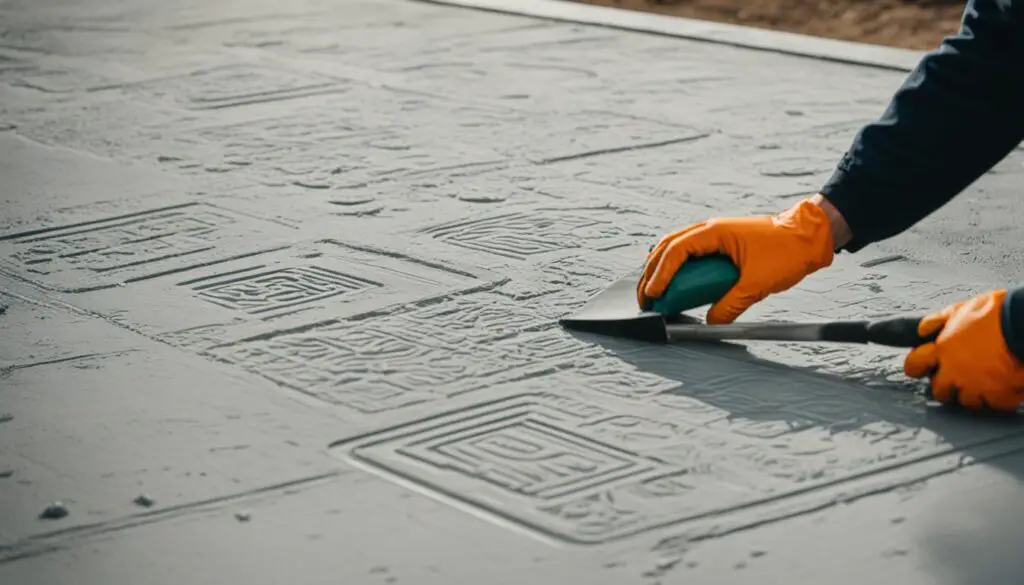
| Advantages | Disadvantages |
|---|---|
| 1. Durable and long-lasting | 1. Potential for cracking over time |
| 2. Customizable designs and patterns | 2. Limited design flexibility |
| 3. Low maintenance requirements | 3. Higher initial cost compared to plain concrete |
| 4. Versatile for various applications | 4. Regular maintenance and resealing needed |
Stamped Concrete Specifications
When it comes to imprinted concrete, meeting specific specifications is crucial to ensure the desired outcome and quality. In this section, we will discuss the key specifications that need to be considered when selecting stamped concrete for your project.
1. Thickness
Stamped concrete should have a suitable thickness to withstand the intended use and provide durability. The thickness may vary depending on factors such as the type of application and the expected load. It is essential to consult with professionals or refer to industry guidelines to determine the recommended thickness for your specific project.
2. Texture
The texture of imprinted concrete plays a significant role in its visual appeal and slip resistance. Depending on the surface’s purpose and the desired aesthetic, various texture options are available, including smooth, textured, or imprinted patterns. It is important to select a texture that complements the overall design and meets any safety requirements, such as providing adequate traction.
3. Pattern
The pattern of stamped concrete allows you to achieve the look of natural materials like stone, brick, or wood. There are numerous patterns available, ranging from traditional to contemporary designs. Consider the surrounding environment and the desired style to choose a pattern that enhances the overall aesthetic and complements your project’s theme.
4. Color
Color is a crucial aspect of imprintedconcrete, as it helps create a cohesive and visually appealing surface. Stamped concrete can be colored using integral pigments or by applying surface stains and dyes. It is essential to choose colors that harmonize with the surroundings, complement the overall design, and provide the desired visual impact.
5. Durability
Stamped concrete should be durable enough to withstand the anticipated traffic, weather conditions, and other environmental factors. It is necessary to select materials and installation techniques that ensure the longevity and performance of the imprinted concrete surface. Consider factors like strength, resistance to wear and tear, and the ability to withstand freeze-thaw cycles when evaluating the durability of stamped concrete.
Understanding the specifications for stamped concrete is vital to ensure a successful and aesthetically pleasing installation. By considering factors such as thickness, texture, pattern, color, and durability, you can select the right specifications that align with your project requirements and design vision.
Now that we have explored the specifications for stamped concrete, let’s move on to the next section, where we will discuss the cost considerations associated with imprinted concrete installations.
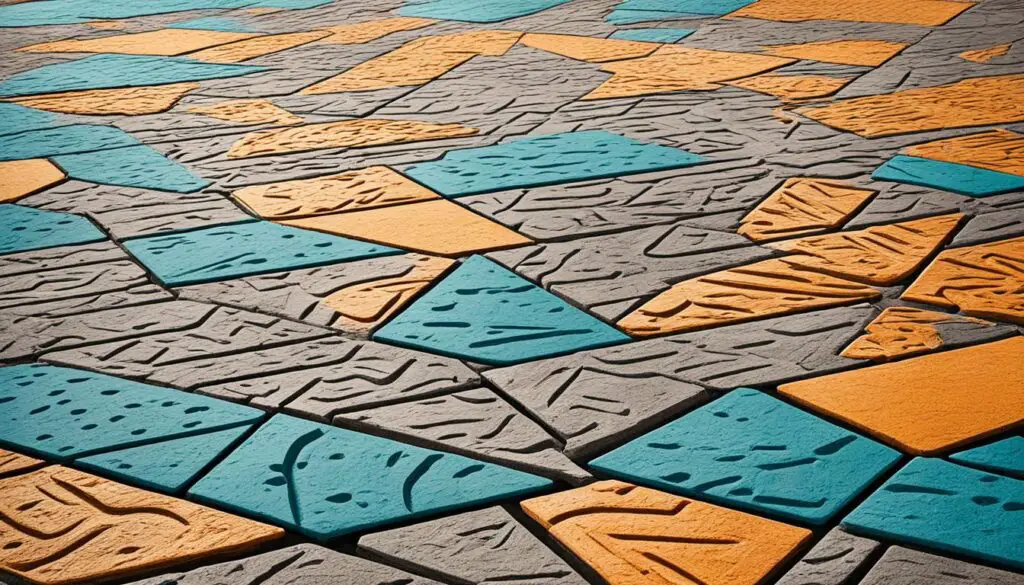
Stamped Concrete Cost
When considering a stamped concrete project, it’s important to understand the associated costs. The cost of stamped concrete can vary depending on several factors, including the size of the project, complexity of the design, materials used, and labor costs. By gaining insights into the average costs, you can better plan and budget for your imprinted concrete installation.
“The cost of stamped concrete can vary depending on several factors, including the size of the project, complexity of the design, materials used, and labor costs.”
Let’s take a closer look at some of the key cost factors:
Project Size
The size of your project plays a significant role in determining the overall cost. Typically, larger projects require more materials and labor, resulting in higher expenses. It’s essential to accurately measure the area you plan to cover with imprinted concrete to estimate the project size correctly.
Design Complexity
If you have a more intricate design in mind, such as a custom pattern or multiple colors, it can affect the cost of your stamped concrete project. Complex designs often require additional labor and materials, which can increase the overall expense.
Materials Used
The choice of materials used for your stamped concrete plays a significant role in determining the cost. Different materials, such as high-quality concrete mixes, color pigments, and sealers, can impact the overall price. It’s essential to discuss the material options with your contractor to find the right balance between cost and quality.
Labor Costs
The labor costs associated with imprinted concrete installations can vary based on factors such as location, contractor experience, and project complexity. It’s crucial to obtain multiple quotes from reputable contractors to compare prices and ensure you’re getting a fair deal.
Here’s a table outlining the average stamped concrete costs for different projects:
| Project Type | Average Cost |
|---|---|
| Stamped Concrete Patio | $12 – $20 per square foot |
| imprinted Concrete Driveway | $10 – $18 per square foot |
| Stamped Concrete Pathway | $8 – $15 per square foot |
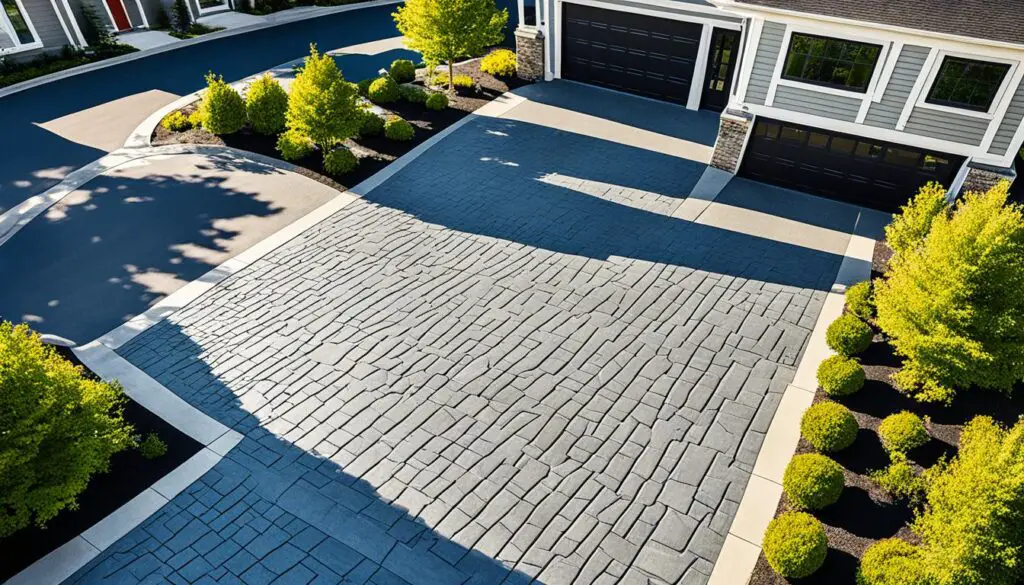
Keep in mind that these costs are approximate and can vary depending on the factors mentioned earlier. It’s always recommended to consult with a professional contractor to get an accurate estimate for your specific project.
Advantages of Stamped Concrete
When it comes to flooring options, imprinted concrete offers several advantages that make it a popular choice for many projects. Whether you’re considering it for your pathways, driveways, patios, or pool decks, understanding the benefits of stamped concrete will help you make an informed decision.
1. Durability
One of the key advantages of stamped concrete is its durability. With proper installation and maintenance, imprinted concrete can withstand heavy foot traffic, vehicles, and the elements. Its solid and robust structure makes it highly resistant to cracking, chipping, and erosion, ensuring long-lasting performance.
2. Customization Options
Stamped concrete offers a wide range of customization options, allowing you to achieve the desired look and feel for your space. With various patterns, textures, and colors available, you can create a unique and personalized design that complements your overall aesthetic. Whether you prefer the look of natural stone, brick, or wood, imprinted concrete can replicate these textures with precision.
3. Low Maintenance Requirements
Compared to other flooring options, stamped concrete requires minimal maintenance. It doesn’t require regular waxing, polishing, or resealing like some traditional materials. Simply sweeping or rinsing the surface regularly and occasional resealing will keep your imprinted concrete looking fresh and vibrant for years to come.
4. Versatility in Design
Stamped concrete offers great flexibility in design, allowing you to create various effects and styles. Whether you want a sleek and modern look or a rustic and traditional appeal, imprinted concrete can be customized to match your vision. Additionally, it can be integrated seamlessly with other outdoor elements, such as landscaping features and pool surrounds, to create a cohesive and visually stunning space.
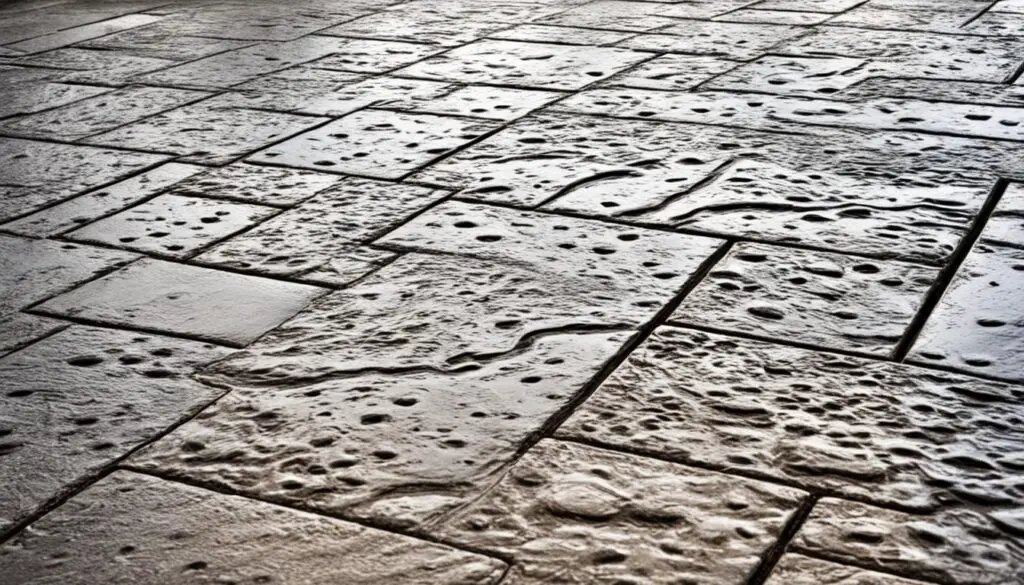
With its durability, customization options, low maintenance requirements, and versatility in design, it’s no wonder that imprinted concrete is a preferred choice for many homeowners and commercial property owners. Whether you’re looking for a cost-effective solution or a beautiful and long-lasting flooring option, stamped concrete delivers on both fronts.
| Advantages of Stamped Concrete |
|---|
| 1. Durability |
| 2. Customization Options |
| 3. Low Maintenance Requirements |
| 4. Versatility in Design |
Disadvantages of Stamped Concrete
While imprinted concrete offers numerous advantages, it’s essential to consider some potential drawbacks before making a decision. Understanding these disadvantages will help you determine if stamped concrete is the right choice for your project. Let’s explore these factors in detail:
- Cost: One disadvantage of imprinted concrete is that it can be expensive compared to other flooring options. The cost includes labor, materials, and the complexity of the design. However, considering its durability and aesthetic appeal, it can still be a cost-effective long-term investment.
- Potential for cracking: Stamped concrete may have a higher risk of cracking compared to traditional concrete due to factors such as improper installation, inadequate base preparation, or temperature fluctuations. While control joints and proper maintenance can minimize the risk, it’s important to be aware of this potential issue.
- Limited design flexibility: Unlike other flooring options like tiles or natural stone, imprinted concrete offers limited design options. While there are various patterns and textures available, the customization options may not be as extensive. If you have a unique or intricate design in mind, you may need to explore alternative materials.
- Need for regular maintenance: Stamped concrete requires regular maintenance to preserve its appearance and longevity. This includes periodic resealing to protect against stains, fading, and wear. Without proper maintenance, the concrete may deteriorate over time.
It’s important to balance the advantages and disadvantages of imprinted concrete to make an informed decision. If you prioritize cost-effectiveness, durability, and the ability to customize within the limitations, stamped concrete may still be an excellent choice for your project.
To fully understand the drawbacks of stamped concrete, let’s take a look at a summarized table below:
| Disadvantages | Description |
|---|---|
| Cost | Stamped concrete can be relatively expensive compared to other flooring options. |
| Potential for Cracking | imprinted concrete may have a higher risk of cracking, especially if not properly installed or maintained. |
| Limited Design Flexibility | Stamped concrete offers fewer design options compared to other materials, limiting customization possibilities. |
| Need for Regular Maintenance | Regular maintenance, such as resealing, is required to preserve the appearance and durability of imprinted concrete. |
Note: The table above provides a summarized overview of the disadvantages of stamped concrete for quick reference.
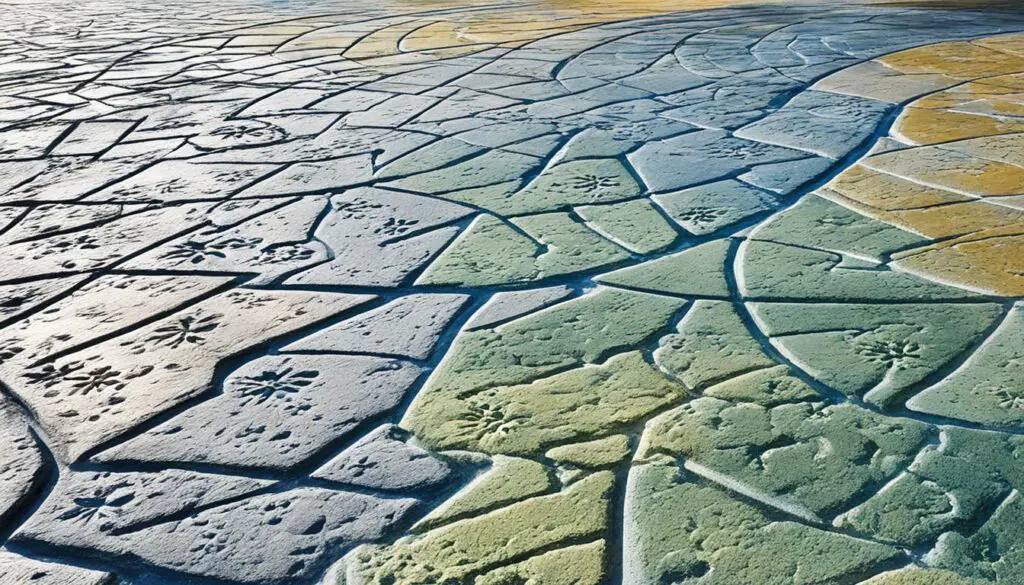
By considering these factors, you can make an informed decision about whether stamped concrete is the right choice for your project.
Conclusion
In conclusion, imprinted concrete is an excellent choice for a wide range of applications, offering versatility, durability, and aesthetic appeal. Whether you are looking to enhance the appearance of your pathways, driveways, patios, or pool decks, stamped concrete can provide a cost-effective solution that mimics the look of more expensive materials like stone, brick, or tile.
Understanding the materials needed and the process involved in creating stamped concrete is essential for a successful installation. By following the right specifications and employing skilled craftsmanship, you can achieve stunning results that will enhance the overall look of your property.
While there are many advantages to using imprinted concrete, it’s important to consider any potential disadvantages as well. For instance, stamped concrete may require regular maintenance and may be more prone to cracking over time. However, by taking proper care of your imprinted concrete surfaces, you can mitigate these challenges and enjoy its long-lasting beauty.
Overall, with its versatility, durability, and customizable design options, imprinted concrete is a highly desirable choice for both residential and commercial projects. Consider the advantages and disadvantages, weigh the materials, process, specifications, and costs, and make an informed decision to achieve the desired look for your next project. Whether it’s for a stunning pathway, an inviting driveway, a cozy patio, or an elegant pool deck, imprinted concrete provides a practical and eye-catching solution that will enhance your space for years to come.
Thanks For the Great Attention!
Good Bye & Take Care
Happy Learning
Also, Read,

